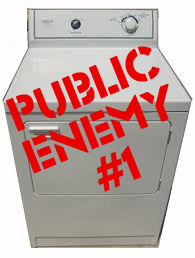In the final analysis, people's ignorance about electrical usage is one of the great tragedies of our time.
That is, if you consider broken homes a 'tragedy'.
Mom and Dad and the two kids go out for hamburgers. They have a great time; as fun a time as any family could wish to have.
They wheel into the driveway, Dad sees that Jimmy left his bedroom light on and explodes. "I've told you a thousand times! That's it! I've had it!"
A horrible fight ensues, with the mother caught in the middle, trying to protect her son from the father's wrath, yet agreeing that the son's extravagant waste of the family's money demands severe punishment.
The rest of the evening is spent with the son sulking, the father in an angry mood, and the mother on the edge of tears. Last night it was her turn because she left the dining room light on when they went across the street to visit with the neighbors for an hour.
After the one thousandth time, the father has had enough and decides to leave these money-wasting losers. Or, tiring of his rage, she does. Or little Jimmy runs away when he's 16 and is found dead from a heroin overdose two months later in New York City.
Just another American family tragedy.
Happens all the time.
The light little Jimmy left on is a 60-watt desk lamp.
Watts means "per hour", so that means Jimmy's light consumes 60 watts of energy in one hour. The family was gone for two hours, so little Jimmy's despicable thoughtlessness wasted 120 watts.
A "kilowatt" is how electricity is measured and paid for. A kilowatt is 1,000 watts. Therefore, to get kilowatts, you divide the watts by 1,000. So, the 120 watts that little Jimmy so blatantly wasted is .12 kilowatt.
One kilowatt generally costs about ten cents.
At ten cents per kilowatt, that's $.012 that little Jimmy wasted that dark and fateful night. The last night, it turned out, that the family was to ever eat a happy meal together.
$.012 is just over one penny.
I once lived with a woman who wasn't very clear on how wildly different electrical usage can be. I decided to make her up a bar graph:
— The first bar on the graph was just a thin, tiny red line. This was things like those plug-in adapters/chargers.
— The next line was just a tiny bit thicker. Room lights.
— Then there was a slightly longer bar. Electronic devices like the computer, TV and stereo.
— Then there was a pretty serious bar going about a third the way across the page. The fridge.
— But going almost all the way across the page was the oven. What a power hog that baby was!
— But wait! Across the very bottom of the page was a bar that went all the way across, then onto a little roll of paper that, when unraveled, rolled to the edge of the desk, dropped over the side and went all the way down to the floor:
The electric clothes dryer.
You know all that electricity you "save" when you conscientiously turn out the lights every time you leave the room? The next time you let the dryer run 5 minutes too long, you've just wiped out your light bulb savings for the previous year.
The same holds true with the electric oven, to a lesser extent. Turn it on 400 degrees for 20 minutes to heat up that slice of garlic bread and you've just pissed away the last six months of light bulb "savings."
The bottom line with electrical usage is that anything that directly makes heat or cold uses 'serious' electricity, and worrying about lesser things is a waste of everyone's time. Those people out there advocating you switch to fluorescent light bulbs to "save energy" would be doing the world a LOT more good if they suggested you run your electric dryer 10 minutes less a month, or used a small toaster oven for that piece of garlic bread, or turned down the thermostat on your electric water heater, or any number of things that would make a real, discernible difference.
Figuring Out the $$
 It's real easy to figure out how much money something costs to run. On almost every appliance is a sticker that has the amount of power it draws. It'll either be in "watts" or "amps".
It's real easy to figure out how much money something costs to run. On almost every appliance is a sticker that has the amount of power it draws. It'll either be in "watts" or "amps".
Let's start at the beginning:
Picture a garden hose. How much water comes out the end depends upon two things; the amount of pressure pushing the water and the size of the hose. Multiply the two together and you get a "per time" figure, like "GPM", or Gallons Per Minute.
With electricity, the two figures are "volts" and "amps". Multiply the two together and you get "watts", which really means "per hour". If a light bulb says "60 watts" on it, that means it uses 60 watts in one hour.
Electrical companies use a bigger measurement, the "Kilowatt", or 1,000 watts. On your utility bill it's abbreviated "KW" or "KWH" (kilowatt hours).
Depending on where you are in the country and a few local factors, a KWH costs somewhere between 8 and 12 cents.
Most appliance stickers give you the figure in amps, whereas smaller things, like light bulbs, give it to you in the 'total figure', watts. If you have the figure in amps, just multiply it by 120 (standard U.S. house voltage) and there's your watts.
 If you either can't read the sticker, or simply want to measure it while it's actually working, you need an "inductive ammeter" to measure how much juice it's drawing. If you can't get to the power cord, like with a built-in oven, just take off the front panel of the circuit breaker box and measure one of the wires there.
If you either can't read the sticker, or simply want to measure it while it's actually working, you need an "inductive ammeter" to measure how much juice it's drawing. If you can't get to the power cord, like with a built-in oven, just take off the front panel of the circuit breaker box and measure one of the wires there.
I just checked Radio Shack's web site and they're selling this little dude for $20, which is an amazingly good price. The good digital ones cost around a hundred bucks. I verified later that the local Shack carries them.
An Example
Computers, while electronic, still use a measurable amount of juice. According to my inductive ammeter, my computer uses 1.2 amps.
To get watts, you multiply the amps times the voltage, so 1.2 amps times 120 volts = 144 watts my computer uses in an hour.
144 watts divided by 1,000 = .14 kilowatt.
.14 kilowatt times $.10 = $.014 an hour to run, or about a penny and a half.
My computer is on about 17 hours a day, so it costs $7.15 a month to run.
I hope this has helped clarify some things. If you really want to do humanity some good, memorize the above formula and the next time you hear someone scream at their kid for leaving the room light on, whip out a piece of paper, do the math, and show them that they just made their kid cry over a tenth of a penny.


 It's real easy to figure out how much money something costs to run. On almost every appliance is a sticker that has the amount of power it draws. It'll either be in "watts" or "amps".
It's real easy to figure out how much money something costs to run. On almost every appliance is a sticker that has the amount of power it draws. It'll either be in "watts" or "amps". If you either can't read the sticker, or simply want to measure it while it's actually working, you need an "inductive ammeter" to measure how much juice it's drawing. If you can't get to the power cord, like with a built-in oven, just take off the front panel of the circuit breaker box and measure one of the wires there.
If you either can't read the sticker, or simply want to measure it while it's actually working, you need an "inductive ammeter" to measure how much juice it's drawing. If you can't get to the power cord, like with a built-in oven, just take off the front panel of the circuit breaker box and measure one of the wires there.